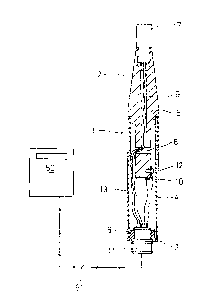Une partie des informations de ce site Web a été fournie par des sources externes. Le gouvernement du Canada n'assume aucune responsabilité concernant la précision, l'actualité ou la fiabilité des informations fournies par les sources externes. Les utilisateurs qui désirent employer cette information devraient consulter directement la source des informations. Le contenu fourni par les sources externes n'est pas assujetti aux exigences sur les langues officielles, la protection des renseignements personnels et l'accessibilité.
L'apparition de différences dans le texte et l'image des Revendications et de l'Abrégé dépend du moment auquel le document est publié. Les textes des Revendications et de l'Abrégé sont affichés :
| (12) Brevet: | (11) CA 1301331 |
|---|---|
| (21) Numéro de la demande: | 1301331 |
| (54) Titre français: | DISPOSITIF SERVANT A MESURER LES FUITES DE VAPEUR |
| (54) Titre anglais: | STEAM LEAKAGE MEASURING DEVICE |
| Statut: | Périmé et au-delà du délai pour l’annulation |
| (51) Classification internationale des brevets (CIB): |
|
|---|---|
| (72) Inventeurs : |
|
| (73) Titulaires : |
|
| (71) Demandeurs : |
|
| (74) Agent: | NORTON ROSE FULBRIGHT CANADA LLP/S.E.N.C.R.L., S.R.L. |
| (74) Co-agent: | |
| (45) Délivré: | 1992-05-19 |
| (22) Date de dépôt: | 1987-03-11 |
| Licence disponible: | S.O. |
| Cédé au domaine public: | S.O. |
| (25) Langue des documents déposés: | Anglais |
| Traité de coopération en matière de brevets (PCT): | Non |
|---|
| (30) Données de priorité de la demande: | ||||||
|---|---|---|---|---|---|---|
|
ABSTRACT
The present invention is of such construction
that a temperature sensor is attached to a vibration
sensor which is used for checking the operation of a
valve of a steam trap and others by detecting vibrations
occurring with the operation of the valve. The
temperature sensed by the temperature sensor is converted
into a saturated pressure and a true steam leakage
corresponding to the steam system pressure is measured
from the relation between the vibration level using the
pressure as a parameter and the steam leakage.
- 8 -
Note : Les revendications sont présentées dans la langue officielle dans laquelle elles ont été soumises.
Note : Les descriptions sont présentées dans la langue officielle dans laquelle elles ont été soumises.

2024-08-01 : Dans le cadre de la transition vers les Brevets de nouvelle génération (BNG), la base de données sur les brevets canadiens (BDBC) contient désormais un Historique d'événement plus détaillé, qui reproduit le Journal des événements de notre nouvelle solution interne.
Veuillez noter que les événements débutant par « Inactive : » se réfèrent à des événements qui ne sont plus utilisés dans notre nouvelle solution interne.
Pour une meilleure compréhension de l'état de la demande ou brevet qui figure sur cette page, la rubrique Mise en garde , et les descriptions de Brevet , Historique d'événement , Taxes périodiques et Historique des paiements devraient être consultées.
| Description | Date |
|---|---|
| Inactive : Renversement de l'état périmé | 2012-12-05 |
| Le délai pour l'annulation est expiré | 2009-05-19 |
| Lettre envoyée | 2008-05-20 |
| Inactive : CIB de MCD | 2006-03-11 |
| Inactive : CIB de MCD | 2006-03-11 |
| Accordé par délivrance | 1992-05-19 |
Il n'y a pas d'historique d'abandonnement
| Type de taxes | Anniversaire | Échéance | Date payée |
|---|---|---|---|
| TM (catégorie 1, 6e anniv.) - générale | 1998-05-19 | 1998-05-05 | |
| TM (catégorie 1, 7e anniv.) - générale | 1999-05-19 | 1999-05-17 | |
| TM (catégorie 1, 8e anniv.) - générale | 2000-05-19 | 2000-04-07 | |
| TM (catégorie 1, 9e anniv.) - générale | 2001-05-21 | 2001-04-20 | |
| TM (catégorie 1, 10e anniv.) - générale | 2002-05-20 | 2002-04-08 | |
| TM (catégorie 1, 11e anniv.) - générale | 2003-05-19 | 2003-04-11 | |
| TM (catégorie 1, 12e anniv.) - générale | 2004-05-19 | 2004-03-31 | |
| TM (catégorie 1, 13e anniv.) - générale | 2005-05-19 | 2005-03-04 | |
| TM (catégorie 1, 14e anniv.) - générale | 2006-05-19 | 2006-05-05 | |
| TM (catégorie 1, 15e anniv.) - générale | 2007-05-21 | 2007-03-05 |
Les titulaires actuels et antérieures au dossier sont affichés en ordre alphabétique.
| Titulaires actuels au dossier |
|---|
| TLV CO., LTD. |
| Titulaires antérieures au dossier |
|---|
| MASAO YONEMURA |